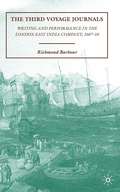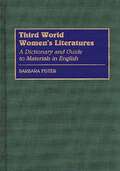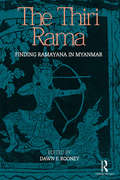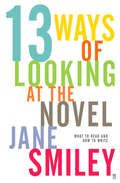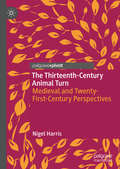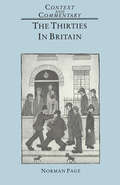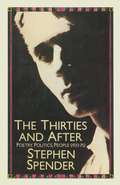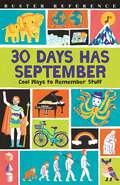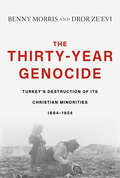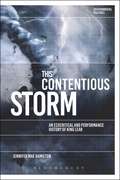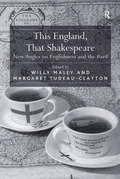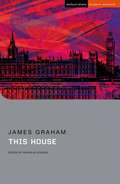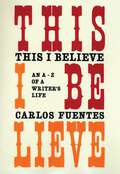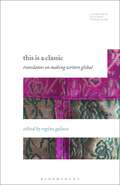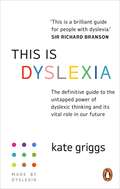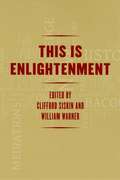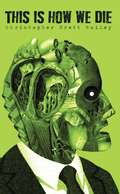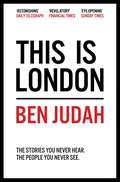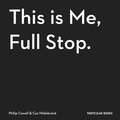- Table View
- List View
The Third Voyage Journals: Writing and Performance in the London East India Company, 1607-10
by R. BarbourThis volume publishes for the first time the collected journals of the East India Company's Third Voyage (1607-10), England's first to reach India, which proved pivotal to England's emergence as a global player.
Third World Women's Literatures: A Dictionary and Guide to Materials in English
by Barbara FisterThis reference volume serves as a companion to Third World women's literatures in English and in English translation by presenting entries on works, writers, and themes. Entries are chosen to present a balance of well-known writers and emerging ones, contemporary as well as historical writers, and representative selections of genres, literary styles, and themes.What plays have been written by women in the developing world? What books have been written by Sri Lankan or Brazilian women? Which works address themes of feminism or exile or politics in the Third World? These are the types of questions that can now be answered through Fister's companion to Third World women's literatures in English and English translation. Organized alphabetically, this reference volume presents entries on works, writers, and themes. Entries are chosen to present a balance of well-known writers and emerging ones, contemporary as well as historical writers, and representative selections of genres, literary styles, and themes.By providing information about and leads to works by and about Third World women, an important and largely marginalized literature, Fister has created a unique reference tool that will help teachers, scholars, and librarians, both public and academic, expand their definitions of the literary, making the voices of Third World women available in the same format in which many companions to Western literature do. An important book for all public and college-level libraries.
The Thiri Rama: Finding Ramayana in Myanmar
by Dawn F. RooneyThe Thiri Rama – or the Great Rama – was written for court performance and is the only known illustrated version of the Ramayana story in Myanmar. Based on palm-leaf manuscripts and scenes carved on over 300 sandstone plaques at a mid-nineteenth-century Buddhist pagoda west of Mandalay in Myanmar, this book presents an original translation of the Thiri Rama rendered in prose. The volume also includes essays on the history and tradition of the Ramayana in Myanmar as well as the cultural context in which the play was performed. It contains many helpful resources, incorporating a glossary and a list of characters and their corresponding personae in Valmiki’s Ramayana. With over 250 fascinating visuals and core text contributions by distinguished Burmese scholars, U Thaw Kaung, Tin Maung Kyi, and U Aung Thwin, this book will greatly interest scholars and researchers of South and Southeast Asian culture, literary forms, epics, art and art history, theatre and performance studies, religion, especially those concerned with Hinduism, as well as folklorists.
The Thiri Rama: Finding Ramayana in Myanmar
by Dawn F. RooneyThe Thiri Rama – or the Great Rama – was written for court performance and is the only known illustrated version of the Ramayana story in Myanmar. Based on palm-leaf manuscripts and scenes carved on over 300 sandstone plaques at a mid-nineteenth-century Buddhist pagoda west of Mandalay in Myanmar, this book presents an original translation of the Thiri Rama rendered in prose. The volume also includes essays on the history and tradition of the Ramayana in Myanmar as well as the cultural context in which the play was performed. It contains many helpful resources, incorporating a glossary and a list of characters and their corresponding personae in Valmiki’s Ramayana. With over 250 fascinating visuals and core text contributions by distinguished Burmese scholars, U Thaw Kaung, Tin Maung Kyi, and U Aung Thwin, this book will greatly interest scholars and researchers of South and Southeast Asian culture, literary forms, epics, art and art history, theatre and performance studies, religion, especially those concerned with Hinduism, as well as folklorists.
Thirteen Ways of Looking at the Novel
by Jane SmileyA Pulitzer Prize-winning author's revelatory celebration of the novel - at once an anatomy of the art of fiction, a guide for readers and writers and a memoir of literary life. Over her 20 year career, Jane Smiley has written many kinds of novels - mystery, comedy, historical fiction, epic. But when her impulse to write faltered after 9/11, she decided to approach novels from a different angle: she read 100 of them, from the 1000-year-old Tale of Genji to the recent bestseller White Teeth by Zadie Smith, from classics to little-known gems. With these books and her experience of reading them as her reference, Smiley discusses the pleasure of reading; why a novel succeeds - or doesn't; and how the form has changed over time. She delves into the character of the novelist and reveals how (and which) novels have affected her own life.
The Thirteenth-Century Animal Turn: Medieval and Twenty-First-Century Perspectives
by Nigel HarrisThe Thirteenth-Century Animal Turn: Medieval and Twenty-First-Century Perspectives examines a wide range of texts to argue in favour of a thirteenth-century animal turn which not only generated a heightened scholarly awareness of animals but also had major implications for society more generally. Using diverse primary sources, the book considers the role of Aristotle in shaping thirteenth-century perspectives on natural history; Pope Innocent III’s encouraging the use of animals in the theological and moral instruction of the laity; the increasing relevance of animals to the promotion and assertion of lay aristocratic identity; and the tension between violence and affection towards animals that pervaded the thirteenth century as it does the twenty-first. Analysing these many considerations, Nigel Harris also argues that the thirteenth century was an era in which traditional conceptions of the fundamental ‘anthropological difference’ between humans and animals was subjected to increasingly urgent questioning and challenge.
The Thirties
by Norman PageThis volume reflects both the social and economic problems at home and the 'threatening horizon' of international affairs which took place in the thirties, culminating in the Munich crisis and the outbreak of war towards the end of the decade. Page's comprehensive and lively selection ranges through the imaginative literature of writers such as W.H.Auden, Stephen Spender, George Orwell, Louis MacNeice and Evelyn Waugh. A historical perspective is provided by extracts from works such as Cole's Short History of the British Working Class Movement and R.H.S.Crossman's The God that Failed. Throughout this book the linking commentary emphasises the exciting background of ideas of Marxian, Freudianism and Science and Technology which came to the forefront of the period.
Thirty Days Has September
by Christopher StevensThirty Days Has September helps with learning all of those confusing rules of language and mathematics, and those tricky facts from science, history and geography. It makes a lovely gift from parent to child and a perfect learning companion to help all school children. It is a treasure trove of easy methods to take important information from the back of the mind to the tip of children's tongues.
The Thirty-Year Genocide: Turkey’s Destruction of Its Christian Minorities, 1894–1924
by Benny Morris Dror Ze’eviFrom 1894 to 1924 three waves of violence swept across Anatolia, targeting the region’s Christian minorities. Benny Morris and Dror Ze’evi’s impeccably researched account is the first to show that the three were actually part of a single, continuing, and intentional effort to wipe out Anatolia’s Christian population and create a pure Muslim nation.
This Contentious Storm: An Ecocritical and Performance History of King Lear (Environmental Cultures)
by Jennifer Mae HamiltonFrom providential apocalypticism to climate change, this ground-breaking ecocritical study traces the performance history of the storm scene in King Lear to explore our shifting, fraught and deeply ideological relationship with stormy weather across time. This Contentious Storm offers a new ecocritical reading of Shakespeare's classic play, illustrating how the storm has been read as a sign of the providential, cosmological, meteorological, psychological, neurological, emotional, political, sublime, maternal, feminine, heroic and chaotic at different points in history. The big ecocritical history charted here reveals the unstable significance of the weather and mobilises details of the play's dramatic narrative to figure the weather as a force within self, society and planet.
This England, That Shakespeare: New Angles on Englishness and the Bard
by Margaret Tudeau-ClaytonIs Shakespeare English, British, neither or both? Addressing from various angles the relation of the figure of the national poet/dramatist to constructions of England and Englishness this collection of essays probes the complex issues raised by this question, first through explorations of his plays, principally though not exclusively the histories (Part One), then through discussion of a range of subsequent appropriations and reorientations of Shakespeare and 'his' England (Part Two). If Shakespeare has been taken to stand for Britain as well as England, as if the two were interchangeable, this double identity has come under increasing strain with the break-up - or shake-up - of Britain through devolution and the end of Empire. Essays in Part One examine how the fissure between English and British identities is probed in Shakespeare's own work, which straddles a vital juncture when an England newly independent from Rome was negotiating its place as part of an emerging British state and empire. Essays in Part Two then explore the vexed relations of 'Shakespeare' to constructions of authorial identity as well as national, class, gender and ethnic identities. At this crucial historical moment, between the restless interrogations of the tercentenary celebrations of the Union of Scotland and England in 2007 and the quatercentenary celebrations of the death of the bard in 2016, amid an increasing clamour for a separate English parliament, when the end of Britain is being foretold and when flags and feelings are running high, this collection has a topicality that makes it of interest not only to students and scholars of Shakespeare studies and Renaissance literature, but to readers inside and outside the academy interested in the drama of national identities in a time of transition.
This England, That Shakespeare: New Angles on Englishness and the Bard
by Margaret Tudeau-ClaytonIs Shakespeare English, British, neither or both? Addressing from various angles the relation of the figure of the national poet/dramatist to constructions of England and Englishness this collection of essays probes the complex issues raised by this question, first through explorations of his plays, principally though not exclusively the histories (Part One), then through discussion of a range of subsequent appropriations and reorientations of Shakespeare and 'his' England (Part Two). If Shakespeare has been taken to stand for Britain as well as England, as if the two were interchangeable, this double identity has come under increasing strain with the break-up - or shake-up - of Britain through devolution and the end of Empire. Essays in Part One examine how the fissure between English and British identities is probed in Shakespeare's own work, which straddles a vital juncture when an England newly independent from Rome was negotiating its place as part of an emerging British state and empire. Essays in Part Two then explore the vexed relations of 'Shakespeare' to constructions of authorial identity as well as national, class, gender and ethnic identities. At this crucial historical moment, between the restless interrogations of the tercentenary celebrations of the Union of Scotland and England in 2007 and the quatercentenary celebrations of the death of the bard in 2016, amid an increasing clamour for a separate English parliament, when the end of Britain is being foretold and when flags and feelings are running high, this collection has a topicality that makes it of interest not only to students and scholars of Shakespeare studies and Renaissance literature, but to readers inside and outside the academy interested in the drama of national identities in a time of transition.
This House (Student Editions)
by James GrahamFor the first time, this play - first performed in 2012 at the National Theatre - is published in the Methuen Drama Student Edition series. It features commentary & notes by Nicholas Holden, Lecturer in Drama at the University of Greenwich, UK, that help the student unpack the play's social, political and cultural context, as well as its themes, language, structure and production history.In tough times, the British do what we have always done. We muddle through.This House is a razor-sharp political comedy exploring Westminster and the 1974 British hung parliament, which provides a timely historical correlative to the current political climate. It's the play that secured the then-30-year-old James Graham's reputation as one of the UK's most important and revered dramatists, gaining critical acclaim, enjoying a sell-out run at the National Theatre's Olivier in 2013 and being revived in the West End in 2017, when it was Olivier-nominated. With well-paced, witty and waspish dialogue, it explores the childish digs and chauvinistic attitudes that have riddled political life both then and continue to do so now.
This House (Student Editions)
by James GrahamFor the first time, this play - first performed in 2012 at the National Theatre - is published in the Methuen Drama Student Edition series. It features commentary & notes by Nicholas Holden, Lecturer in Drama at the University of Greenwich, UK, that help the student unpack the play's social, political and cultural context, as well as its themes, language, structure and production history.In tough times, the British do what we have always done. We muddle through.This House is a razor-sharp political comedy exploring Westminster and the 1974 British hung parliament, which provides a timely historical correlative to the current political climate. It's the play that secured the then-30-year-old James Graham's reputation as one of the UK's most important and revered dramatists, gaining critical acclaim, enjoying a sell-out run at the National Theatre's Olivier in 2013 and being revived in the West End in 2017, when it was Olivier-nominated. With well-paced, witty and waspish dialogue, it explores the childish digs and chauvinistic attitudes that have riddled political life both then and continue to do so now.
This I Believe: An A-Z of a Writer's Life
by Carlos FuentesCarlos Fuentes is Mexico's most admired novelist, and this is his manifesto, and memoir, offering a rare and wonderful insight into the mind of a great writer. This I Believe is an A to Z of the things that he loves and believes in. In a series of inspired meditations and polemics, he embraces his subjects such as 'Balzac' and 'Beauty' and 'Sex' and 'Shakespeare'. The essays are woven together with the familiar Fuentes themes of politics, time and language, and through them runs the vein of his personal journey, his views on love, sex, women, friendship and family. From 'Amor' to 'Zürich', this is a collection of thoughts that is both witty and profoundly searching.
This Is a Classic: Translators on Making Writers Global (Literatures, Cultures, Translation)
by Regina GalassoThis Is a Classic illuminates the overlooked networks that contribute to the making of literary classics through the voices of multiple translators, without whom writers would have a difficult time reaching a global audience. It presents the work of some of today's most accomplished literary translators who translate classics into English or who work closely with translation in the US context and magnifies translators' knowledge, skills, creativity, and relationships with the literary texts they translate, the authors whose works they translate, and the translations they make. The volume presents translators' expertise and insight on how classics get defined according to language pairs and contexts. It advocates for careful attention to the role of translation and translators in reading choices and practices, especially regarding literary classics.
This Is a Classic: Translators on Making Writers Global (Literatures, Cultures, Translation)
This Is a Classic illuminates the overlooked networks that contribute to the making of literary classics through the voices of multiple translators, without whom writers would have a difficult time reaching a global audience. It presents the work of some of today's most accomplished literary translators who translate classics into English or who work closely with translation in the US context and magnifies translators' knowledge, skills, creativity, and relationships with the literary texts they translate, the authors whose works they translate, and the translations they make. The volume presents translators' expertise and insight on how classics get defined according to language pairs and contexts. It advocates for careful attention to the role of translation and translators in reading choices and practices, especially regarding literary classics.
This is Dyslexia: The definitive guide to the untapped power of dyslexic thinking and its vital role in our future
by Kate GriggsThe future needs Dyslexic Thinking! British social entrepreneur, founder and CEO of charity Made By Dyslexia, Kate Griggs has been shifting the narrative on dyslexia and educating people on its strengths since 2004. Having been surrounded by an extraordinary 'smorgasbord of Dyslexic Thinking' her whole life, Griggs knows the superpower of dyslexia all too well. With a forward from Sir Richard Branson, This is Dyslexia covers everything you need to understand, value and support Dyslexic Thinking. From offering practical advice on how to support the dyslexics in your life to breaking down the 6 Dyslexic Thinking skills in adults, Griggs shares her knowledge in an easily digestible guide. This is Dyslexia redefines and reshapes what it means to be dyslexic. It explores how it has shaped our past and how harnessing its powers and strengths is vital to our future.
This Is Enlightenment
by Clifford Siskin William WarnerDebates about the nature of the Enlightenment date to the eighteenth century, when Imanual Kant himself addressed the question, “What is Enlightenment?” The contributors to this ambitious book offer a paradigm-shifting answer to that now-famous query: Enlightenment is an event in the history of mediation. Enlightenment, they argue, needs to be engaged within the newly broad sense of mediation introduced here—not only oral, visual, written, and printed media, but everything that intervenes, enables, supplements, or is simply in between. With essays addressing infrastructure and genres, associational practices and protocols, this volume establishes mediation as the condition of possibility for enlightenment. In so doing, it not only answers Kant’s query; it also poses its own broader question: how would foregrounding mediation change the kinds and areas of inquiry in our own epoch? This Is Enlightenment is a landmark volumewith the polemical force and archival depth to start a conversation that extends across the disciplines that the Enlightenment itself first configured.
This Is Enlightenment
by Clifford Siskin William WarnerDebates about the nature of the Enlightenment date to the eighteenth century, when Imanual Kant himself addressed the question, “What is Enlightenment?” The contributors to this ambitious book offer a paradigm-shifting answer to that now-famous query: Enlightenment is an event in the history of mediation. Enlightenment, they argue, needs to be engaged within the newly broad sense of mediation introduced here—not only oral, visual, written, and printed media, but everything that intervenes, enables, supplements, or is simply in between. With essays addressing infrastructure and genres, associational practices and protocols, this volume establishes mediation as the condition of possibility for enlightenment. In so doing, it not only answers Kant’s query; it also poses its own broader question: how would foregrounding mediation change the kinds and areas of inquiry in our own epoch? This Is Enlightenment is a landmark volumewith the polemical force and archival depth to start a conversation that extends across the disciplines that the Enlightenment itself first configured.
This Is Enlightenment
by Clifford Siskin William WarnerDebates about the nature of the Enlightenment date to the eighteenth century, when Imanual Kant himself addressed the question, “What is Enlightenment?” The contributors to this ambitious book offer a paradigm-shifting answer to that now-famous query: Enlightenment is an event in the history of mediation. Enlightenment, they argue, needs to be engaged within the newly broad sense of mediation introduced here—not only oral, visual, written, and printed media, but everything that intervenes, enables, supplements, or is simply in between. With essays addressing infrastructure and genres, associational practices and protocols, this volume establishes mediation as the condition of possibility for enlightenment. In so doing, it not only answers Kant’s query; it also poses its own broader question: how would foregrounding mediation change the kinds and areas of inquiry in our own epoch? This Is Enlightenment is a landmark volumewith the polemical force and archival depth to start a conversation that extends across the disciplines that the Enlightenment itself first configured.
This Is How We Die (Oberon Modern Plays)
by Christopher Brett Baileya motor-mouthed collage of spoken word and storytelling. tales of paranoia, young love and ultra-violence… from the desk of christopher brett bailey comes a spiraling odyssey of pitch-black humour and nightmarish prose. THIS IS HOW WE DIE is a prime slice of surrealist trash, an Americana death trip and a dizzying exorcism for a world convinced it is dying…
This is London: Life and Death in the World City
by Ben Judah'Judah grabs hold of London and shakes out its secrets' The EconomistThis is London in the eyes of its beggars, bankers, coppers, gangsters, carers, witch-doctors and sex workers. This is London in the voices of Arabs, Afghans, Nigerians, Poles, Romanians and Russians.This is London as you've never seen it before.'An eye-opening investigation into the hidden immigrant life of the city' Sunday Times'Full of nuggets of unexpected information about the lives of others . . . It recalls the journalism of Orwell' Financial Times
This Is Me, Full Stop.: The Art, Pleasures, and Playfulness of Punctuation
by Caz Hildebrand Philip CowellFrom the cutting-edge London design agency Here Design - writer and poet Philip Cowell, and award-winning designer Caz Hildebrand, author of The Herbarium, this playful, original, beautifully designed book brings to life the punctuation marks we use every day, including:The dashing dash - So-called "quotation marks"The colon: and on and on.The shouty exclamation!The three dots of...(Not forgetting the brackets)And even more
